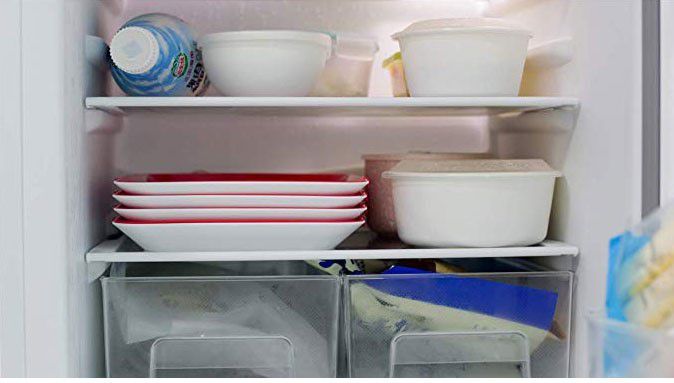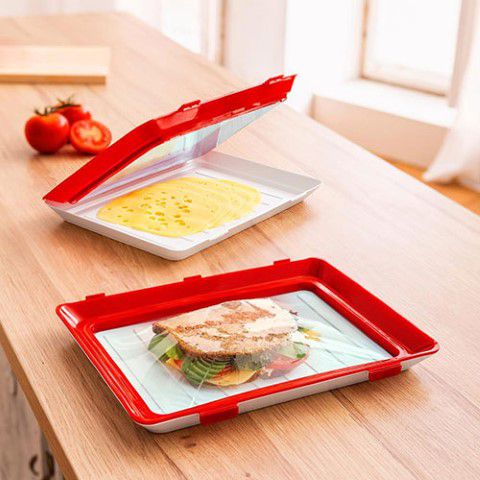
Did you know that in the United States alone, 40% of food ends up in the dumpster? To put it into perspective, this amounts to more than $160 billion going to waste every year, according to the U.S. Department of Agriculture.
It always feels horrible when we are forced to toss away any fruits, fish, dairy or meat that goes bad simply because of improper storage.
In this post, I will share some tips on how to organize your food inside the fridge so it preserves the same taste and freshness.
General tips
Organizing your fridge thoughtfully
One of the most common mistakes people make is putting too much stuff in the fridge. Stacking food closely blocks air circulation, interfering with the optimum working of your fridge.

By organizing your fridge thoughtfully, it is easy to maintain proper air flow and even temperatures.
Increasing the air flow and maintaining an even temperature in your fridge reduces the rate at which food becomes rancid.
Fridge compartments
To give the food in your fridge their maximum shelf-life, it is important to understand how the various compartments control temperature. This will help you decide where to place different foodstuffs.
For instance:
- It’s best to store meat, dairy and eggs on the lower shelves of the main compartment since this area is normally the coldest.
- Place leftovers, prepared meals, drinks and herbs on the top shelves.
- Condiments, water, drinks and other products that do not go bad easily can go on the door since the temperature here is highly inconsistent and often warmer.
- Store all fruits and vegetables in sealed drawers to avoid cross-contamination.
- Do not place foods against the back wall of the fridge.
- Aim to separate the stuff in your fridge by at least half an inch.
Cleaning your fridge helps keep things fresh
The fridge gets dirty with time, and we recommend a full cleaning of the sides and inside every three months. Cleaning your appliance with hot, soapy water or bleach kills the bacteria that are normally responsible for causing food to go bad.
If you are using bleach, the ideal ratio is one tablespoon of bleach for every gallon of water.
How to keep your fridge smelling fresh
To keep your fridge smelling clean and fresh, keep an open box of baking soda on the second or third shelf. Replace the baking soda every 1-3 months for the best results.
How to best store leftovers
Experts recommend that you store all leftovers in leak-proof, preferably airtight containers or wraps. Our favourites are these Food Preservation Trays. They are air tight and can keep all kinds of food fresh, helping to maintain the flavour and freshness for eons. They are also reusable as well as dishwasher and microwave friendly.

As a rule of thumb, refrigerate leftover food within a couple of hours of cooking.
It is not necessary to wait for the food to cool down before storing – modern fridges can take care of the heat.
To ensure consistent freshness, stick to the “first in, first out rule”, meaning you always eat the oldest leftovers in the fridge first. Lastly, it is a bad idea to store canned foods once they are open. These include:
- Soup broth.
- Tuna fish.
- Cranberry juice.
- Tomato paste.
Best practices for storing meat, fish and poultry
Meat, fish and poultry are best kept in the coldest spot in your fridge. This is often at the bottom, but not always. Ideally, these products should stay in a separate drawer with the temperature set to 29° F.
Another important step to maintain the freshness of fresh meat, poultry and fish is storing the product in its store wrapping. Re-wrapping these foods increases the chances of exposure to bacteria. If the storage is not leak proof, you can slide a plate underneath the fish or meat to catch any drippings.
Storing dairy products
When you buy new dairy products, for example, a gallon of fresh milk, place it in the back and bring any older boxes to the front. This way, you will get rid of the products nearing their expiration date first.
In any case, DO NOT store milk in the compartments on the door since this section tends to be warmest. The door is best for non-perishable drinks and condiments.
Typically, plastic bottles do a better job preserving milk compared to cardboard boxes. Bacteria and mold can grow near the spout of a milk carton and find its way into your glass. However, as long as the milk has not expired yet, it should be okay to consume from a box.
When it comes to cottage cheese, yogurt, cream and sour cream, leave them in their original storage. Nevertheless, if you transfer cream or milk to a different container, such as a bowl or pitcher, be sure to cover the container tightly with a plastic wrap.
Lastly, for hard cheeses, leave them in their original storage until you have to use them. After opening the store wrapping, cover them in loose plastic, foil or wax paper.
How to keep fruits and vegetables fresh and crunchy for longer
For fruits and vegetables to stay fresh and crispy, it is best to separate them from other foods, and keep like with like. For example, carrots should be kept with carrots, bananas with bananas and apples with apples. Fruits and vegetables produce different enzymes that can cause the rest to go bad quicker.
To store fruit or vegetables that have been cut already, an airtight container such as the Food Preservation Tray works perfectly.
There are fruits and vegetables that dry out easily such as carrots. For such, it is best to keep them in an unsealed or perforated container. This will allow ample air circulation while still maintaining the necessary moist environment.
Finally, do not refrigerate fruits and vegetables while still wet. The dampness increases the chances of mold and rotting.
Best practices for storing bread and pasta
Fresh pasta should be stored in the fridge. Dry pasta, on the other hand, should just be kept in the pantry inside an airtight container.
Similarly, it is not necessary to refrigerate breads, though the cooler environment could prevent mold from developing. If you live in a humid environment, especially, you can keep bread in the fridge.
Furthermore, blocks of butter and margarine do not require refrigeration. It is okay to store butter on a flat tray with a cover. For some brands of butter that begin to separate when not cooled, you can place such in the door compartments or on the front side of the shelves. This will also help maintain the butter’s flavour and taste.
Conclusion
Throwing away food sucks, luckily, by applying a few simple strategies and tips, we can reduce this wastage by up to 95%, according to the Federal Food Safety website. You can save money, reduce your carbon footprint and feel great about yourself by never throwing away food again.